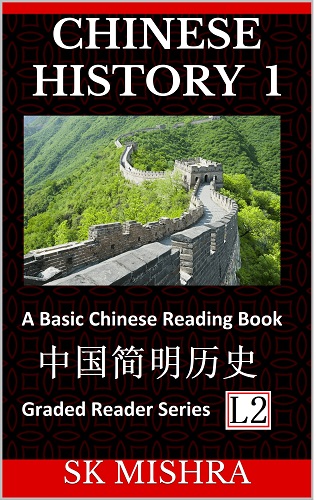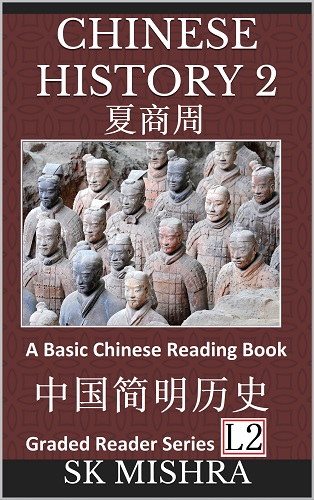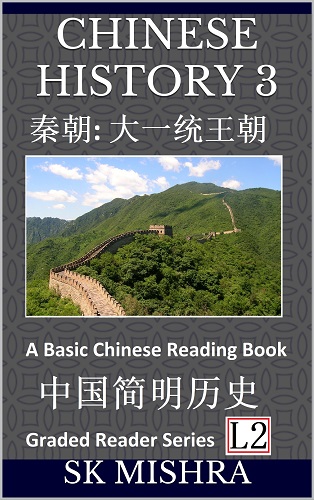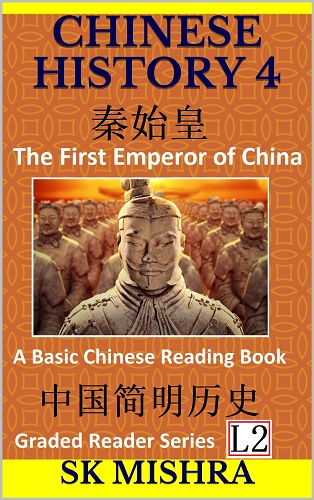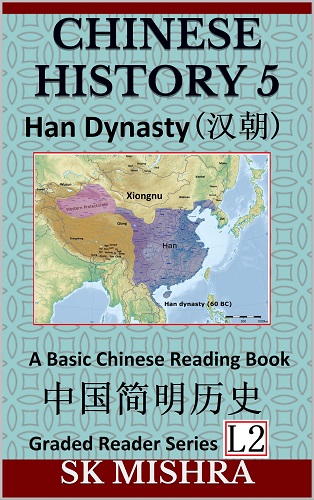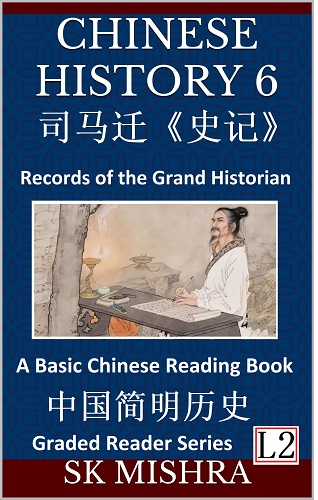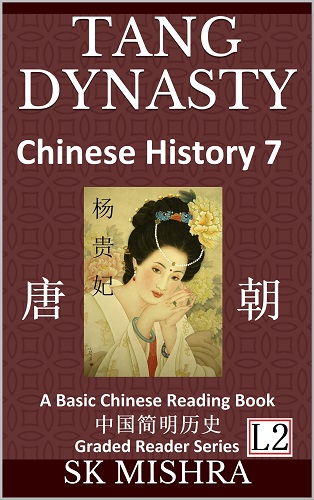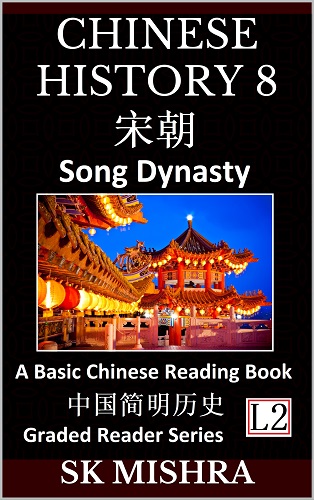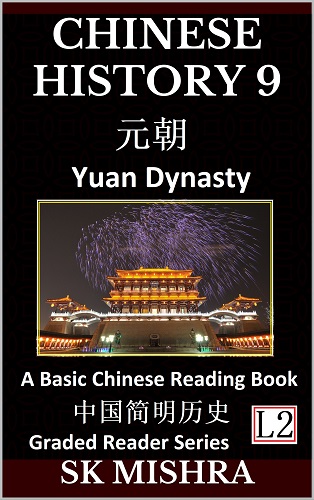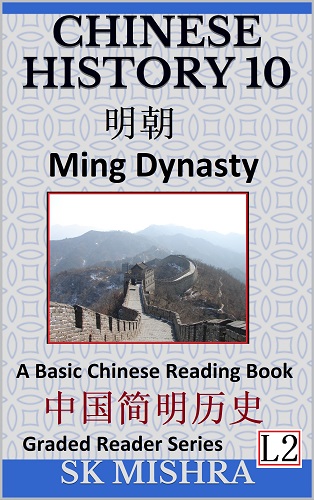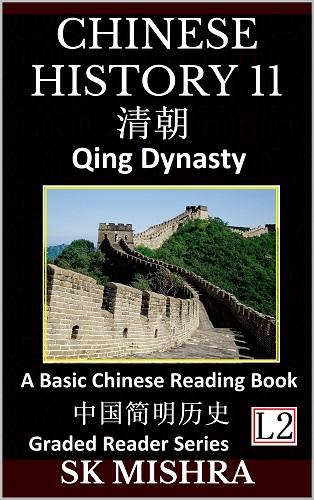Are you learning Mandarin Chinese? Great! Welcome to this long and time-consuming journey. Well, learning Chinese is indeed a long journey. However, we can spice the things up by learning the real Chinese historical events. In fact, Chinese history is about 5000 years old. No wonder, for the non-native learners, there are simply lots to uncover from China’s vibrant past. In the previous post, I recommended Level 1 books (each volume made of about 600 unique Mandarin characters) to practice Mandarin Chinese reading. All the books are also available on the author’s home page (for readers in Japan, please click here Amazon Japan).
Assuming you have already gone through the very first level of Mandarin learning journey, in this blog-post, let’s go through the Level 2 books (further Level 3 readings: Chinese Culture Series). These books, each made of about 900 unique characters, are about the Chinese History. Btw, if you are new to the Chinese language learning, and wondering how to learn the mysterious Chinese characters, check out the following links:
Here are the recommended book volumes to learn Chinese history while practicing Chinese reading.
Learn Chinese Language and Culture
Here are some of the related books/resources to learn Chinese language fast:
- Level 1: Chinese Reading Books (Chinese Elementary/Primary School Education Series)
- Level 1: Chinese Reading Books (Chinese Short Story Series, 500+ characters)
- Level 1: Chinese Reading Books (Journey to the West Series, 600 characters)
- Level 2: Chinese Reading Books (Biographies of China’s Famous Personalities, 600 characters)
- Level 2: Chinese Reading Books (Chinese Reading Comprehension, 600+ characters)
- Level 2: Chinese Reading Books (Chinese History Series, 900 characters)
- Level 3: Chinese Reading Books (Chinese Culture Series, 1000 characters)
- Level 4 & 5: Chinese Reading Books (Chinese Geography and Economy Series, over 1000 characters)
- Level 6: Chinese Reading Books (Chinese Classical Literature Masterpieces, about 1300 characters)
Chinese History Series (Level 2 Books)
Chinese history refers to the history of China from the birth of Chinese civilization (中华文明) to the present. The Xia period of Neolithic Erligang Culture (新石器时代二里岗文化) was already present by 2070 BC (approximately 4,100 years ago). The first unification of China took place in 221 BC under the Qin Dynasty (approximately 2240 years ago). As such, China has a very long history.
Here are the recommended book volumes to learn Chinese history while practicing Chinese reading.
Chinese History 1: Overview- from prehistory to the People’s Republic of China.
The book, Chinese History 1, a Chinese reading practice book, presents a broad and simple overview of Chinese history.
- Paperback (ISBN 9798887340234): Barnes & Noble
- Paperback (ISBN 9798887340234): Amazon
Chinese History 2: Three Dynasties
The book, Chinese History 2, provides you the details of San Dai (三代, sān dài), meaning “the three generations”, basically the three early dynasties of China. Yet another beginner’s book for Chinese reading practice.
- Paperback (ISBN 9798887340500): Barnes & Noble
- Paperback (ISBN 9798887340500): Amazon
Chinese History 3: Qin Dynasty
The book, Chinese History 3, presents a broad and simple overview of the Qin Dynasty (221 BCE –207 BCE) and their contributions. In fact, the Qin Dynasty was the first dynasty to unify whole China. Although Qin Dynasty was the shortest in Chinese history, and often abused the people’s power, it had a huge influence on the following dynasties. As such, the establishment of a centralized government system by the Qin Dynasty laid the basic pattern of governance for the coming 2000 years.
- Paperback (ISBN 9798887340517): Barnes & Noble
- Paperback (ISBN 9798887340517): Amazon
Chinese History 4: Emperor Qin Shi Huang
Qin Shi Huang (秦始皇, 259 BCE -210 BCE) was an ancient Chinese politician, strategist and reformer. He defeated the six Warring States (Han, Zhao, Wei, Chu, Yan and Qi) and completed the political unification of China for the first time. He established a unified, multi-ethnic country with the centralized power. As a founder of the powerful Qin Dynasty (221 BCE –207 BCE), he was the first monarch in China to be called an emperor. The so called “first emperor”, Qin Shi Huang Di, laid the basic structure of China’s political system for the coming two thousand years.
- Paperback (ISBN 9798887340524): Barnes & Noble
- Paperback (ISBN 9798887340524): Amazon
Chinese History 5: The Han Dynasty
The Han Dynasty (汉朝, 206 BCE–220 CE) was the second great imperial unification dynasty of China. The dynasty, with 24 recognized emperors, ruled China for over 400 years. The reign of the Han Dynasty is broadly divided into the Western Han Dynasty (西汉) and the Eastern Han Dynasty (东汉). The period of the Han Dynasty is termed as the golden age in Chinese history.
- Paperback (ISBN 9798887340531): Barnes & Noble
- Paperback (ISBN 9798887340531): Amazon
Chinese History 6: Si Ma Qian
Si Ma Qian (139 BC – 86 BC) was a Chinese historian and essayist of the Western Han Dynasty (西汉). He is widely regarded as the father of Chinese historiography for his acclaimed treatise Records of the Grand Historian《史记》. The book, Chinese History 6, a Chinese reading practice book, presents a broad and simple overview about the life and legacies of Si Ma Qian.
- Paperback (ISBN 9798887340548): Barnes & Noble
- Paperback (ISBN 9798887340548): Amazon
Chinese History 7: Tang Dynasty
The Tang Dynasty (618–907 CE) succeeded the short-lived Sui Dynasty (581–618 CE). The new dynasty was a very important Chinese dynasty that was founded by Li Yuan (with Chang’an as the capital) after overthrowing the Sui Dynasty. In fact, the Tang Empire was one of the most powerful countries in the world at that time. The Tang Dynasty had 21 emperors and ruled China for nearly 290 years. Due to its immense contribution to China’s growth and development, the Tang Dynasty period is often termed as China’s golden age.
- Paperback (ISBN 9798887340555): Barnes & Noble
- Paperback (ISBN 9798887340555): Amazon
Chinese History 8: Song Dynasty
The Song Dynasty (宋朝, 960-1279) was a powerful Chinese ruling dynasty. It inherited legacies of the Five Dynasties and the Ten Kingdoms (五代十国) and was succeeded by the Yuan Dynasty (元朝). The rule of the Song Dynasty was divided into two stages, the Northern Song Dynasty (北宋) and the Southern Song Dynasty (南宋). The Song Dynasty had 18 emperors and ruled for about for 320 years. However, after 1127, the Song Dynasty ruled only in South China.
- Paperback (ISBN 9798887340562): Barnes & Noble
- Paperback (ISBN 9798887340562): Amazon
Chinese History 9: Yuan Dynasty
The Yuan Dynasty (元朝, 1271-1368), was the first ruling dynasty of the unified China established by a ruler from the minority (Mongolian) clan. In 1206, Genghis Khan unified various Mongolian ministries and established the Great Mongolian Empire (蒙古帝国). In 1271, Kublai Khan established the Yuan Dynasty. The dynasty ruled China for 98 years. This was the first dynasty to declare Beijing (大都) as China’s capital city.
- Paperback (ISBN 9798887340579): Barnes & Noble
- Paperback (ISBN 9798887340579): Amazon
Chinese History 10: Ming Dynasty
The Ming Dynasty (1368-1644), also known as the Great Ming (大明), was the last Chinese ruling dynasty established by the Han nationality. The dynasty had total 16 emperors and ruled China for a total of 276 years. After the collapse of the Yuan dynasty (元朝), the peasant rebel leader Zhu Yuanzhang (朱元璋) founded the Ming dynasty. Zhu Yuanzhang ruled China as Emperor Taizu (明太祖) and introduced several socio-economics reforms. In the late Ming dynasty, however, the peasant uprising broke out. In 1644, Li Zicheng (李自成, 1606-1645) invaded Beijing that eventually led to collapse of the Ming Dynasty.
- Paperback (ISBN 9798887340586): Barnes & Noble
- Paperback (ISBN 9798887340586): Amazon
Chinese History 11: Qing Dynasty (the last imperial dynasty)
The Qing Dynasty (1636-1912) was the last feudal dynasty in Chinese history. The Manchurian dynasty, with 12 emperors, ruled China for about 276 years. The Manchus maintained the capital at Beijing (Romanized as Peking). During the early years of Qing Dynasty, China’s traditional society achieved unprecedented development achievements. The Kangxi Emperor (康熙), the longest reigning of any Chinese emperor, ushered in what historians call the Great Qing (大清). However, due to multiple conflicts, such as the First Opium War, the Second Opium War, the Taiping Rebellion, etc., the dynasty finally collapsed in 1911.
- Paperback (ISBN 9798887340593): Barnes & Noble
- Paperback (ISBN 9798887340593): Amazon
As and when I have a new book to recommend for the Level 2 learners, I will update the list.
To sum up, Mandarin Chinese is arguably one of the most difficult languages to learn. However, if you learn smartly, you can indeed learn Chinese much faster. Although the road to learning Chinese is certainly not an easy one, it’s absolutely worth it!
Once you have done enough reading practices, you will be able to read any random piece of Chinese manuscript.
That’s all in this post about How to Practice Fast Reading Chinese Books. If you have any question about learning Mandarin Chinese, traveling, living or working in China, do let me know in the comments! Feel free to post in our forum so that others could also contribute and learn. For regular updates like us on Facebook, or follow on Twitter!
If you find the write-ups useful, don’t forget to buy me a beer!
Wish you a great time learning Mandarin Chinese!
Cheers!
Last updated: Friday, December 9, 2022
